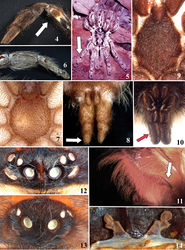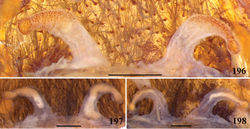Avicularia merianae
| Notice: | This page is derived from the original publication listed below, whose author(s) should always be credited. Further contributors may edit and improve the content of this page and, consequently, need to be credited as well (see page history). Any assessment of factual correctness requires a careful review of the original article as well as of subsequent contributions.
If you are uncertain whether your planned contribution is correct or not, we suggest that you use the associated discussion page instead of editing the page directly. This page should be cited as follows (rationale):
Citation formats to copy and paste
BibTeX: @article{Fukushima2017ZooKeys, RIS/ Endnote: TY - JOUR Wikipedia/ Citizendium: <ref name="Fukushima2017ZooKeys">{{Citation See also the citation download page at the journal. |
Ordo: ORDO
Familia: FAMILIA
Genus: Avicularia
Name
Avicularia merianae Fukushima & Bertani, 2017 sp. n. – Wikispecies link – ZooBank link – Pensoft Profile
Diagnosis
Females of Avicularia merianae sp. n. resemble those of Avicularia purpurea by the spermathecae with weakly-sclerotized area at least same length of well-sclerotized area (Fig. 196). They differ from Avicularia purpurea by dark brown dorsal abdomen, and by lacking dark short body setae with very intense purple sheen on legs and palps. Males of Avicularia merianae sp. n. resemble those of Avicularia avicularia, Avicularia rufa. Avicularia juruensis, Avicularia variegata stat. n., Avicularia taunayi and Avicularia purpurea by tibial apophysis on leg I with well-developed base and grouped spiniform setae distally (Fig. 194). They can be distinguished from all these species except Avicularia purpurea by cymbium lacking well-developed process on retrolateral lobe (Fig. 192). It differs from Avicularia purpurea by lacking velvety black abdomen and dark short body setae with very intense purple sheen on legs and palps.
Etymology
It was named after Maria Sybilla Merian, the German-born naturalist who drew the famous engraving of a specimen of Avicularia eating a bird, in recognition to her importance for Natural Sciences. This extraordinary woman was one of the pioneering female scientists and a remarkable artist. This name is considered feminine in gender.
Material examined
Holotype male, 1 female and 3 immatures paratypes, Peru, department of San Martín, Hara, 20 miles SE from Moyobamba [6°01'S, 76°58'W], F. Woytkowski col., 1–30 June 1947 (AMNH Pe102).
Additional material
PERU: San Martín: Tarapoto [6°07'S, 75°57'W], 830 m a.s.l., 7 females, 1 juvenile female, 2 immature males, 15 immatures, 1 spiderling, F. Woytkowski col., 10–18 February 1947 (AMNH Pe106, Pe105, Pe108); Ekin, west of Tarapoto, 1 young female, under fallen tree, 890 m a.s.l., F. Woytkowski col., 9–21 March 1947 (AMNH Pe104); 1 immature male, under fallen bark, same collector and date (AMNH Pe107); Moyobamba [6°01'S, 76°58'W], Hara, 20 miles southeast of Moyobamba, 4 males, 12 females, 3 juvenile females, 22 immatures, 1 spiderling, F. Woytkowski, 1–30 June 1947 (AMNH Pe98, Pe103, Pe100, Pe53, Pe99, Pe101, AMNH tube, AMNH tube); Rio Huallaga [7°47'S, 76°11'W], 1 immature male, J. C. Pallister col., 15 December 1946 (AMNH Pe112).
Male
Description.
AMNH Pe102. Carapace: 13.49 long, 12.80 wide, 3.48 high. Chelicera: 3.46 long. Legs (femur, patella, tibia, metatarsus, tarsus and total): I: 13.41, 7.59, 10.39, 9.96, 6.21, 47.56. II: 12.75, 7.14, 9.89, 9.44, 5.48, 44.70. III: 11.01, 5.86, 8.57, 9.13, 5.46, 40.03. IV: 14.15, 7.03, 12.05, 11.85, 5.54, 50.62. Palp: 7.98, 4.78, 5.87, –, 2.45, 21.08. Midwidths: femora I–IV=2.45, 2.51, 2.39, 2.55, palp= 1.85; patellae I–IV= 2.58, 2.90, 2.51, 2.89, palp= 1.99; tibiae I–IV= 2.09, 2.05, 2.06, 2.16, palp= 1.69; metatarsi I–IV= 1.68, 1.57, 1.53, 1.33; tarsi I–IV= 1.56, 1.70, 1.67, 1.51, palp= 1.88. Abdomen: 16.35 long, 10.45 wide. Spinnerets: PMS, 2.15 long, 0.94 wide, 0.44 apart; PLS, 2.38 basal, 1.88 middle, 3.00 distal; midwidths 1.30, 1.26, 1.17, respectively.
Carapace: 1.06 times longer than wide; cephalic region not raised, thoracic striae inconspicuous.
Fovea: deep, recurve, 1.78 wide.
Eyes: eye tubercle 1.16 high, 1.97 long, 2.61 wide. Clypeus absent. Anterior eye row procurve. Posterior eye row slightly recurve. Eye size and interdistances: AME 0.72, ALE 0.72, PME 0.21, PLE 0.54, AME–AME 0.32, AME–ALE 0.37, AME–PME 0.12, ALE–ALE 1.78, ALE–PME 0.90, PME–PME 1.71, PME–PLE 0.07, PLE–PLE 2.07, ALE–PLE 0.39, AME–PLE 0.40.
Maxilla: length to width: 1.96. Cuspules: 236 spread over ventral inner heel. Labium: 1.62 long, 1.89 wide, with 101 cuspules spaced by one diameter from each other, on anterior half. Labio-sternal groove shallow, flat, with no evident sigilla.
Chelicera: basal segment with 12 teeth and some small teeth on promargin. Sternum: 7.04 long, 6.04 wide. Sigilla: anterior pair not evident, middle fusiform, posterior ellipsoidal, in a 45°angle, both less than one diameter from margin.
Legs: Formula: IV=I II III. Length leg IV to leg I: 1.06. Clavate trichobothria: distal 2/3 of tarsi I–IV. Scopula: Tarsi I–IV fully scopulate. Metatarsi I fully scopulate, II–III 2/3; IV 1/4 distal scopulate. IV divided by a row of setae.
Type II urticating setae: 0.82–0.92 long, 0.016–0.019 wide.
Palp (Figs 188–191): globous bulb with small subtegulum and developed prominence on tegulum. Embolus: not flattened, lacking keels, 3.83 long in retrolateral view, about 3.0 times tegulum’s length. Medial portion and tegulum’s margin form an acute angle in retrolateral view. Proximal part very curved in frontal view; thin distal width, tapering distally; basal, middle, and distal width 0.81, 0.21, 0.03, respectively. Tegulum: 2.07 long, 1.20 high in retrolateral view. Cymbium subtriangular with subequal lobes, lacking process on retrolateral lobe (Fig. 192).
Tibial apophysis (Figs 193–195): a single branch on prolateral leg I, with well-developed base and grouped spiniform setae distally. Male metatarsus I touches retrolaterally tibial apophysis’ setae when folded.
Color pattern: carapace brown with golden short body setae with pink sheen. Carapace border with long setae the same color as dorsal carapace short body setae. Coxae, labium, sternum and maxillae light brown, same color of ventral femora. Legs and palps with golden brown short body setae with pink sheen and brown long guard-setae. Leg rings on distal femora, tibiae and metatarsi whitish. Abdomen with orange brown guard-setae homogeneously distributed and dark brown body setae. Abdomen venter brown.
Female
Description.
AMNH Pe102. Carapace: 14.57 long, 13.15 wide, 3.83 high. Chelicera: 6.14 long. Legs (femur, patella, tibia, metatarsus, tarsus, total): I: 10.75, 6.90, 7.99, 6.72, 5.15, 37.51. II: 9.99, 6.52, 7.31, 6.41, 4.67, 34.90. III: 9.04, 5.59, 6.88, 6.54, 4.88, 32.93. IV: 11.37, 6.50, 9.66, 8.82, 4.38, 40.73. Palp: 7.95, 4.77, 4.70, –, 5.35, 22.77. Midwidths: femora I–IV= 2.68, 3.02, 3.05, 2.88, palp= 2.09; patellae I–IV= 2.82, 2.79, 2.77, 2.90, palp= 2.34; tibiae I–IV= 2.29, 2.35, 2.59, 3.11, palp= 2.29; metatarsi I–IV= 2.07, 2.05, 1.90, 2.05; tarsi I–IV= 2.24, 2.27, 2.09, 2.12, palp= 2.37. Abdomen: 17.49 long, 11.96 wide. Spinnerets: PMS, 2.08 long, 1.01 wide, 0.16 apart; PLS, 2.37 basal, 1.11 middle, 2.65 distal; midwidths 1.78, 1.49, 1.21, respectively.
As in male, except:
Carapace: 1.11 times longer than wide.
Fovea: slightly recurve, 1.77 wide.
Eyes: eye tubercle 0.70 high, 2.07 long, 2.91 wide. Clypeus 0.30. Eye size and interdistances: AME 0.72, ALE 0.70, PME 0.28, PLE 0.55, AME–AME 0.50, AME–ALE 0.47, AME–PME 0.19, ALE–ALE 2.03, ALE–PME 0.71, PME–PME 1.64, PME–PLE 0.16, PLE–PLE 2.11, ALE–PLE 0.49, AME–PLE 0.52.
Maxilla: length to width: 2.02. Labium: 1.77 long, 2.41 wide, with 96 cuspules spaced by one diameter from each other, on anterior half.
Chelicera: basal segment with 9 teeth and some small teeth on promargin. Sternum: 7.17 long, 5.92 wide.
Legs: Length leg IV to leg I: 1.09 Clavate trichobothria: on distal 1/2 tarsi I–IV. Scopula: Tarsus IV with sparse setae. Metatarsi II fully scopulate; III 1/2, IV 1/3 distal scopulate.
Type II urticating setae: 0.49–0.60 long, 0.014–0.017 wide.
Spermathecae (Fig. 196): two completely separated, not-twisted long spermathecae, with walls lacking projections or lobes and accentuaded outwards curvature medially. Midwidth expanded, about 1.5 times its basal and apical portion widths and weakly-sclerotized area at least same length of well-sclerotized area.
Color pattern (Fig. 199): as in male.
Color pattern ontogeny
Brownish juveniles lacking metallic sheen, black tarsi contrasting with other lighter articles and abdomen dorsum reddish, with dorsal central longitudinal black stripe connected only with anterior pair of transversal black stripes. When mature, both males and females lose this pattern.
Distribution
Peru, department of San Martín (Fig. 105).
Natural history
Unknown.
Original Description
- Fukushima, C; Bertani, R; 2017: Taxonomic revision and cladistic analysis of Avicularia Lamarck, 1818 (Araneae, Theraphosidae, Aviculariinae) with description of three new aviculariine genera01 ZooKeys, (659): 1-185. doi
Images
|





